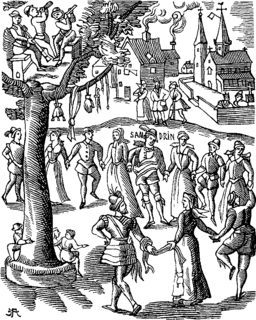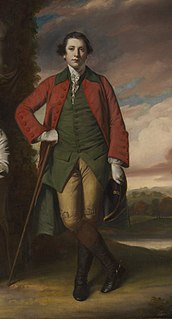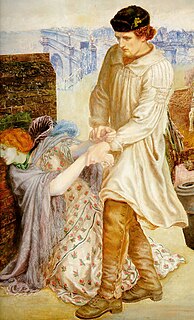
A festival is an event ordinarily celebrated by a community and centering on some characteristic aspect of that community and its religion or cultures. It is often marked as a local or national holiday, mela, or eid. A festival constitutes typical cases of glocalization, as well as the high culture-low culture interrelationship. Next to religion and folklore, a significant origin is agricultural. Food is such a vital resource that many festivals are associated with harvest time. Religious commemoration and thanksgiving for good harvests are blended in events that take place in autumn, such as Halloween in the northern hemisphere and Easter in the southern.

A top hat is a tall, flat-crowned hat for men traditionally associated with formal wear in Western dress codes, meaning white tie, morning dress, or frock coat. Traditionally made of black silk or sometimes grey, the top hat emerged in Western fashion by the end of the 18th century. Although it declined by the time of the counterculture of the 1960s, it remains a formal fashion accessory. A collapsible variant of a top hat, developed in the 19th century, is known as an opera hat.
A tailcoat is a knee-length coat characterised by a rear section of the skirt, known as the tails, with the front of the skirt cut away.

Formal wear or full dress is the Western dress code category applicable for the most formal occasions, such as weddings, christenings, confirmations, funerals, Easter and Christmas traditions, in addition to certain state dinners, audiences, balls, and horse racing events. Formal wear is traditionally divided into formal day and evening wear, implying morning dress before 6 p.m., and white tie after 6 p.m. Generally permitted other alternatives, though, are the most formal versions of ceremonial dresses, full dress uniforms, religious clothing, national costumes, and most rarely frock coats. In addition, formal wear is often instructed to be worn with official full size orders and medals.

Frock has been used since Middle English as the name for an article of clothing, typically coat-like, for men and women.

A frock coat is a formal men's coat characterised by a knee-length skirt cut all around the base just above the knee, popular during the Victorian and Edwardian periods (1830s–1910s). It is a fitted, long-sleeved coat with a centre vent at the back and some features unusual in post-Victorian dress. These include the reverse collar and lapels, where the outer edge of the lapel is often cut from a separate piece of cloth from the main body and also a high degree of waist suppression around the waistcoat, where the coat's diameter round the waist is less than round the chest. This is achieved by a high horizontal waist seam with side bodies, which are extra panels of fabric above the waist used to pull in the naturally cylindrical drape. As was usual with all coats in the 19th century, shoulder padding was rare or minimal.

A costume party or fancy dress party is a type of party, common in contemporary Western culture, in which many of the guests are dressed in costume, usually depicting a fictional or stock character, or historical figure. Such parties are popular in the United States, United Kingdom, Canada, Australia, and New Zealand, especially during Halloween.

Buddha's Birthday is a Buddhist festival that is celebrated in most of East Asia and South Asia commemorating the birth of the Prince Siddhartha Gautama, later the Gautama Buddha, who was the founder of Buddhism. According to Buddhist tradition, Gautama Buddha was born c. 563–483 BCE in Lumbini, Nepal.

Spats, a shortening of spatterdashes, or spatter guards are a type of classic footwear accessory for outdoor wear, covering the instep and the ankle. Spats are distinct from gaiters, which are garments worn over the lower trouser leg as well as the shoe.

A smock-frock or smock is an outer garment traditionally worn by rural workers, especially shepherds and waggoners, in parts of England and Wales throughout the 18th century. Today, the word smock refers to a loose overgarment worn to protect one's clothing, for instance by a painter.

Sherwani is a long-sleeved outer coat worn by men in South Asia. Like the Western frock coat it is fitted, with some waist suppression; it falls to below the knees and is buttoned down the front. It can be collarless, have a shirt-style collar, or a stand-up collar in the style of the Mandarin collar. It evolved in India in the 19th-century as a result of the outer garment of the late Mughal period, the angarkha, itself evolved from the Persian cape, balaba, being given a western style with a button-down front.

In the United Kingdom, the Chairman of Ways and Means is a senior member of the House of Commons who acts as one of the Speaker's three deputies. The incumbent is Dame Eleanor Laing, MP for Epping Forest, who was first elected to the office on 8 January 2020.

Alexa Chung is a British writer, blogger, television presenter, internet personality, model, and fashion designer. She wrote the book It (2013). Her fashion label Alexa Chung, stylized ALEXACHUNG, launched in May 2017 and closed in 2022.
Western dress codes are dress codes in Western culture about what clothes are worn for what occasion. Classifications are divided into formal wear, semi-formal wear, and informal wear (undress). Anything below this level is referred to as casual wear, although sometimes in combinations such as "smart casual" or "business casual" in order to indicate higher expectation than none at all.

An over-frock coat is a formal overcoat designed to be worn over a frock coat if needed in cold weather. A top-frock coat may also be worn over a frock coat in milder weather. Shaped like the body coats popular in the Victorian and Edwardian periods, the over-frock coat was cut in essentially the same way as the frock coat that was worn under it, although it would be larger overall to accommodate the frock-coat worn underneath. Like the frock coat, the over-frock would typically be single-breasted, with step lapels for informal occasions like business, and double-breasted with pointed lapels for formal occasions – weddings, funerals, balls, etc. The top-frock was usually double breasted. The formal variety was sometimes called a Prince Albert overcoat. The Prince Albert top frock, from the later half of the 19th century, originally had a three-inch-wide velvet collar, and flap pockets at the hip, until 1893, when it became even more fitted, longer, and double-breasted.

Sensation is an indoor electronic dance music event which originated in Amsterdam, Netherlands, and organized by ID&T. The original event, which ran exclusively in the Amsterdam Arena for a period of five years until 2005, is now located throughout various European and a few non-European countries.

The Chesterfield is a formal, dark, knee-length overcoat with a velvet collar introduced around the 1840s in the United Kingdom, with prominence attributed to its namesake George Stanhope, 6th Earl of Chesterfield, then a leader of British fashion.

Halloween, a contraction of "All Hallows' Eve", is a celebration observed on October 31, the day before the feast of All Hallows', also known as Hallowmas or All Saint's Day. The celebrations and observances of this day occur primarily in regions of the Western world, albeit some traditions vary significantly between geographical areas.

Formal trousers, also known as formal striped trousers or colloquially spongebag trousers, are grey striped or patterned formal trousers for day attire in traditional Western dress code, primarily associated with formal morning dress or secondly its semi-formal equivalent black lounge suit. Traditionally made from heavy wool ranging from worsted, melton to partial twill weave, the pattern is most often of a muted design in stripes of black, silver, white and charcoal grey in various combinations. In addition, formal trousers may also come in check patterns, such as houndstooth check, or plaids, although these variants are widely considered as not the most formal.
Ruta Anna "Ruth" Tarvydas was an Australian fashion designer. Born in Germany to Lithuanian parents, her family emigrated to Perth, Western Australia, when Tarvydas was two years old. She opened her first boutique at the age of 19, with her brother, and shortly after established her first label. In 1983, Taryvdas became the first Australian designer to export clothing overseas. By the 2000s, she had designs being sold in 170 outlets across 16 countries, with a number of celebrity clients, both in Australia and overseas. A flagship store in King Street, Perth, was opened in 2009, but closed three years later with Tarvydas in heavy debt. A new store was opened in Claremont in 2012, and was featured with Tarvydas in a 2013 ABC1 documentary. Tarvydas was to debut at Paris Fashion Week in 2014, but she died two months before the event.
















